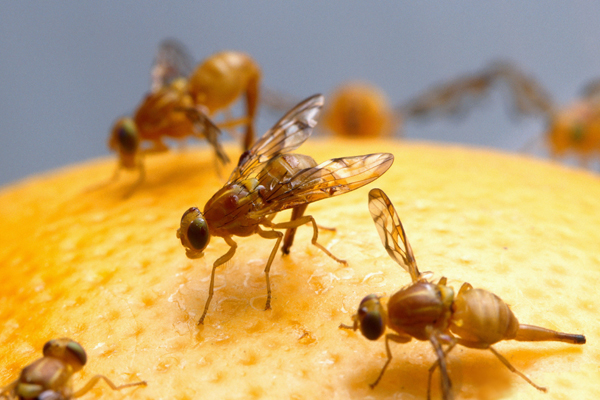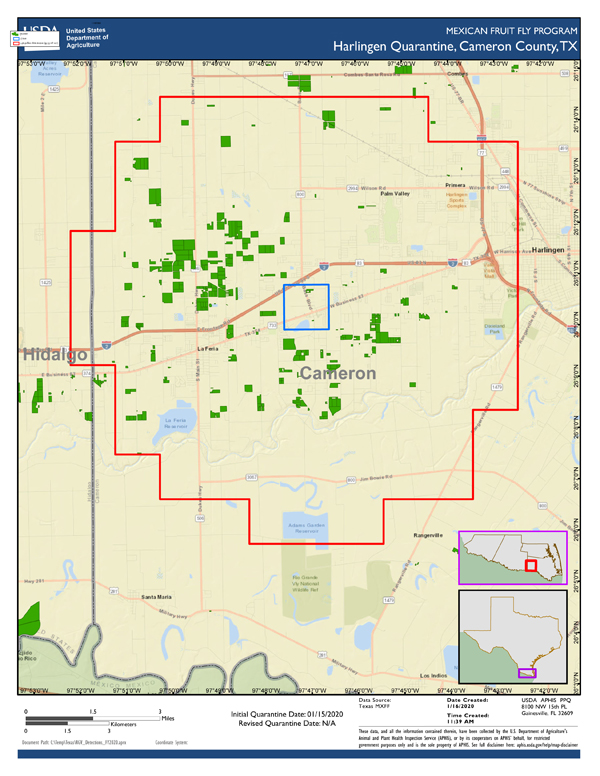- La Feria Community Holds Succesful Business Mixer Event
- Little Nashville to Take Place in Downtown Mercedes
- Lions Basketball Captures District Gold
- La Feria ISD Students Compete in Regional Chess Tournament
- Lions End First Half of 32-4A on a High Note
- La Feria ISD Held Another Successful Parent Conference
- Strong Appearance for Lions at Hidalgo Power Meet
- LFECHS Students Get to Meet Local Actress
- Students Participate in Marine Biology Camp
- Two LFECHS Students Qualify for All-State Band
Mexican Fruit Fly Infestation Brings Quarantine to La Feria
- Updated: January 31, 2020

Selling oranges in the open market could face a barrier because of the Mexican fruit fly. Photo: Tony Vindell/LFN
by Tony Vindell/LFN
The La Feria area has been put back in a quarantine zone due to an infestation of the Mexican fruit fly.
Scores of flies have been discovered on a tree of a private property, referred to as a door yard, in this centrally located city, causing concern for the multi-million-dollar industry.
The fly is native to Central and Southern Mexico and appears in this country from time to time.
According to the Texas Department of Agriculture, damage occurs when a female fly lays eggs in the fruit which then hatch into larvae, making the fruit unmarketable.
The fly can be put at bay through surveillance, bait spray and sterile insect technique, or SIT.
Dale Murden, executive director with the Texas Citrus Mutual, an industry organization, said the flies were found on a door yard tree.
“That prompted TDA to declare a quarantine area,” he said.
“It covers a four and half mile radius in La Feria.”
Murden said they are advising property owners to remove any fruit from trees to stop the spread of the fly.
If the fly is not controlled, growers have no choice but to start spraying all orchards – something which takes time and money.
RGV farmers have some 30,000 acres planted with citrus.
The ruling came less than two and a half months after La Feria area was removed from the list.
On the other hand, the Harlingen area was added to the list this Jan. 15, covering an 81-mile radius of Cameron County and the eastern edge of Hidalgo County.

The Mexican Fruit Fly (Anastrepha ludens) is a serious pest to various fruits, particularly citrus and mango. Mexican fruit fly was first found in Central Mexico in 1863, and by the early 1950s flies were found along the California-Mexico border. The pest has since been detected in Arizona, California and Texas. In grapefruit as well as many other fruits, one female Mexican fruit fly can deposit large numbers of eggs: up to 40 eggs at a time, 100 or more a day, and about 2,000 over her life span Photo: Jack Dykinga, USDA Agricultural Research Service, United States/Wikipedia
Below is a news release about the Mexican Fruit Fly Quarantine in Cameron County.
“There is a Mexican fruit fly quarantine in Cameron County. More than 400 square miles in Cameron and Willacy counties combined are under quarantine because of the Mexican fruit fly. A quarantine is a defined area where fruit cannot be moved INTO or OUT of the area. Mexican fruit fly is an invasive pest that attacks citrus and 40 other types of fruits and nuts including avocado, apples, guava, and apples. Mexican fruit fly is not native to the U.S and therefore has no natural predators to keep it in check. According to the U.S. Department of Agriculture, a quarantine area is triggered when five flies are found within a three mile radius. The quarantine can be burdensome for growers. Costing them thousands of dollars.
The USDA, Texas Department of Agriculture, Texas citrus industry, and local government are working together to eliminate this invasive fruit fly from the Lower Rio Grande Valley. Currently there are agricultural teams who are checking trees, hanging traps, treating trees, and releasing sterile fruit flies to decrease the wild population. The Mexican fruit is not dangerous to humans or pets.
USDA is asking for assistance from the public to do the following:
- Do not move any fruits out of the quarantine areas.
- Remove all fruit from your trees and eat it or dispose of it.
- Keep your fruit in your yard. It is against the law to move your fruit within the quarantine or out of the quarantine, This means you cannot share it with your neighbors, drop it off at a community event, or donate it to a food bank.
- Cooperate with any quarantine restrictions that might be imposed in your area
- Allow authorized agricultural workers access to your property to conduct treatments and trapping activities
Visit https://www.aphis.usda.gov/aphis/resources/pest-diseases/hungry-pests for more information”



